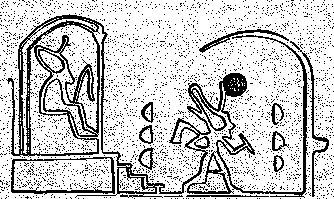2. Makoi is the one who should describe the island, put names on everything. He represents Saturn who has as his task to make fire in the darkest of winter, and by the light from such a fire it becomes clear where everything is located. We should remember the ancient rituals in Egypt at the time when a new fire was created. For instance was number 4 - as in the number of holes in the pair of stones at the entrance to our hare paega - a part of the play: Five days of illumination, called the 'Lighting of the Flame' (which in the earlier reading of this miracle play would have followed the quenching of the fires on the dark night of the moon when the king was ritually slain), preceded the five days of the festival itself; and then the solemn occasion (ad majorem dei gloriam) commenced. The opening rites were under the patronage of Hathor. The king, wearing the belt with her four faces and the tail of her mighty bull, moved in numerious processions, preceded by his four standards, from one temple to the next, presenting favors (not offerings) to the gods. Thereafter the priesthoods arrived in homage before his throne, bearing the symbols of their gods. More processions followed, during which, the king moved about - as Professor Frankfort states in his account - 'like the shuttle in a great loom' to re-create the fabric of his domain, into which the cosmic powers represented by the gods, no less than the people of the land, were to be woven ... ... The king, wearing now a short, stiff archaic mantle, walks in a grave and stately manner to the sanctuary of the wolf-god Upwaut, the 'Opener of the Way', where he anoints the sacred standard and, preceded by this, marches to the palace chapel, into which he disappears. A period of time elapses during which the pharaoh is no longer manifest. When he reappears he is clothed as in the Narmer palette, wearing the kilt with Hathor belt and bull's tail attatched. In his right hand he holds the flail scepter and in his left, instead of the usual crook of the Good Shepherd, an object resembling a small scroll, called the Will, the House Document, or Secret of the Two Partners, which he exhibits in triumph, proclaiming to all in attendance that it was given him by his dead father Osiris, in the presence of the earth-god Geb. 'I have run', he cries, 'holding the Secret of the Two Partners, the Will that my father has given me before Geb. I have passed through the land and touched the four sides of it. I traverse it as I desire.' The idea evidently is to recreate the structure of the 'land' because it has been 'submerged' in the darkkess of watery night. Below the belt there is no structure, as the design of Pachamama 'proves':
The kuhane of Hau Maka made a first preliminary such voyage of naming by flying around above Easter Island, and this was in the night at the end of the previous generation (that of Hau Maka and Hua Tava), just like when close to the end of his reign the king of Egypt moved about 'like a shuttle in a great loom to re-create the fabric of his domain'. After light has been restored the renewed Pharaoh says he has run through his land and touched all 4 sides of it. Makoi is given a similar task by Ira, and thus in a way he could expect to be the new ruler of the island. Easter Island lies outside the tropics, and to create fire (light) is therefore a more important task than closer to the equator. ... the lack of a name for the island as a whole 'was quite in accord with the islander's habits of mind to speckle his home with names changing every few feet and to leave the major divisions nameless' ... (Métraux citing William Churchill) From this perspective we can also get a new idea regarding the meaning of kai viri kai viri ('unforgotten' as Barthel translated it). It could work like a magic formula to disperse the darkness. By retaining something in memory it is not completely gone and it can be recreated. Kai viri presumably means to disappear at the western horizon, but to say it once more should negate the first negation. |

